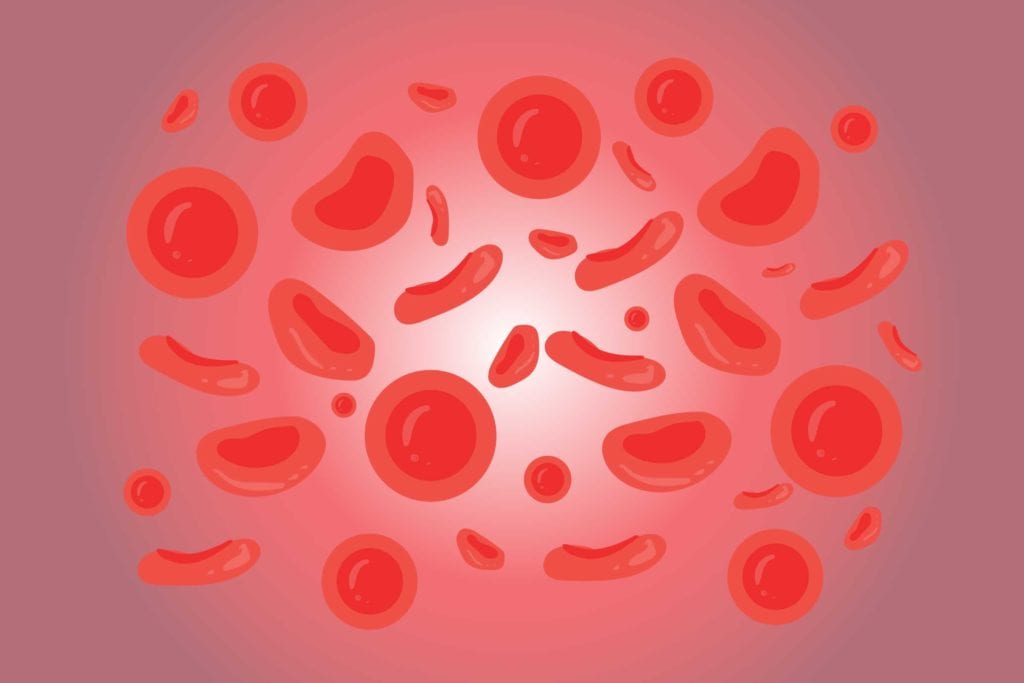

Anemia is a condition that develops when your blood is short on red blood cells or hemoglobin — an iron-rich protein that allows red blood cells to carry oxygen from your lungs to the rest of your body. With your body can’t circulate enough oxygen, it can leave you feeling tired and weak. Anemia is the most common blood disorder; according to the National Heart, Lung, and Blood Institute, it affects more than 3 million Americans.
So what does anemia have to do with rheumatoid arthritis (RA) and other forms of inflammatory arthritis?
A lot, actually. A research review published in the American Journal of Medicine found anemia can occur in up to 60 percent of RA patients. Other research shows anemia affects about half of people with lupus; mild cases of anemia may be seen in psoriatic arthritis.
What Causes Anemia in People with Inflammatory Arthritis?
There are many different forms of anemia and each has its own cause.
Anemia of Chronic Disease
One type — called anemia of chronic disease, or ACD — is a major cause of anemia in people with RA. In one study of 225 RA patients, ACD accounted for 77 percent of the observed anemia. It’s also the most common form of anemia in lupus patients.
Also called anemia of inflammation, ACD affects people who have conditions that cause inflammation, such as infections, cancer, chronic kidney disease, and autoimmune diseases (like RA or lupus).
With ACD, you may have normal or sometimes increased amounts of iron stores in your body tissue, but a low level of iron in your blood. Chronic inflammation may prevent your body from using the stored iron to create new red blood cells, which leads to anemia. Inflammation can also affect the way your body produces a specific hormone called erythropoietin, which controls the production of red blood cells. A 2008 study of 111 patients with early RA reported the prevalence of ACD to be 25 percent during the first year of disease.
Getting inflammation under control with medication is the best way to treat this kind of anemia.
Iron Deficiency Anemia
Iron deficiency anemia — the most common type of anemia — also occurs in people with inflammatory arthritis. It is caused by a shortage of iron in both body tissues and blood. Your bone marrow needs iron to make hemoglobin; without adequate iron, your body can’t produce enough hemoglobin for red blood cells.
Iron deficiency anemia often occurs because of blood loss. In people with inflammatory arthritis, taking nonsteroidal anti-inflammatory drugs (NSAIDs) — used to relieve pain and help reduce inflammation — can cause ulcers or gastritis, which may lead to gastrointestinal bleeding, and in turn, iron-deficiency anemia.
It’s critical to be aware of gastrointestinal complications if you’re using NSAIDs, especially at a high dose or for an extended period of time. Read more about GI warning signs and how to protect yourself.
How Other Medications Affect Anemia in Arthritis
Aside from NSAIDs, other medications may lead to forms of anemia as well.
Some disease-modifying anti-rheumatic drugs (DMARDs) — like methotrexate (Rheumatrex, Trexall, Otrexup, Rasuvo), sulfasalazine (Azulfidine), and leflunomide (Arava) — used to treat RA have been associated with aplastic anemia. This rare, but serious, form of anemia occurs when there’s damage to your bone marrow and your body stops producing enough new blood cells. Loss of bone marrow caused by certain drugs used to treat lupus (such as azathioprine or cyclophosphamide) can also reduce red blood cell production, according to the Lupus Foundation of America.
Different types of anemia are treated in different ways. Your doctor will need to determine the cause of your anemia in order to figure out next steps.
What Are the Symptoms of Anemia?
RA-related anemia is typically mild and develops slowly, causing few or no symptoms. Feeling tired or weak or having fatigue is a common sign of anemia, but this also occurs as part of normal disease activity in inflammatory arthritis. If you have fatigue from your chronic disease, it can be hard to tell if you might also have anemia. This is why routine blood testing at the doctor to detect anemia (more on this below) is important.
If your anemia becomes more severe, however, the lack of oxygen in your blood can cause more telltale signs of anemia, such as:
- Pale skin
- Irregular heartbeats
- Feeling faint, dizzy, or light-headed
- Shortness of breath
- Cold hands and feet
- Headache
- Chest pain
How Is Anemia Diagnosed?
Anemia can be detected during routine bloodwork at doctor visits. Any abnormalities in the following could indicate anemia:
- Number of red blood cells
- Levels of hemoglobin in your blood
- Number of developing red blood cells (called reticulocytes)
- Size, shape, and color of red blood cells for any irregularity
- Amount of iron in your blood
- Amount of iron stored in your body
Your doctor can also pick up on certain signs of anemia while performing a physical exam, such as while listening to your heart or lungs and pressing on your abdomen.
How Is Anemia Treated?
Managing your inflammatory arthritis is step one if you have ACD. Reducing inflammation in the body can help alleviate both joint symptoms and anemia, and improve your overall well-being.
If you have low iron levels contributing to your anemia, your doctor may suggest taking iron supplements and making changes to your diet. In some cases, adjustments may be made to your RA meds. If you suspect you have anemia, talk to your doctor, who can determine the safest steps for you.
If symptoms of anemia become severe, your doctor may consider doing a blood transfusion or injections of a synthetic hormone called erythropoietin, which may help stimulate red blood cell production.
Treating anemia is critical to not only help you feel better from symptoms like fatigue, but also to prevent serious health complications, such as heart problems like an irregular heartbeat or heart failure.





